The Validity of Kiyosaki’s Economic Warnings: A Comprehensive Analysis
Introduction: The Man Behind the Message
Robert Kiyosaki, a name synonymous with financial education and controversy, has once again captured headlines with his dire economic predictions. The author of the bestselling “Rich Dad Poor Dad” series has built a career on challenging conventional financial wisdom. His latest warnings paint a picture of an impending economic catastrophe that could surpass the severity of the 1929 Great Depression. But how much credence should we give to these predictions, and what should investors do in response?
The Core of Kiyosaki’s Argument: Debt, Bubbles, and Monetary Policy
Kiyosaki’s forecast is built upon several interconnected macroeconomic factors that he believes are creating a perfect storm for economic collapse.
The National Debt Crisis
At the heart of Kiyosaki’s argument is the escalating U.S. national debt, which has surpassed $34 trillion. He contends that this debt level is unsustainable, particularly when coupled with ongoing government spending. Kiyosaki argues that the constant printing of money to service this debt devalues the dollar, erodes purchasing power, and leads to inflation. This inflation, he believes, is a hidden tax on savers and a precursor to economic instability.
The Everything Bubble Phenomenon
Kiyosaki’s concept of the “Everything Bubble” refers to a situation where multiple asset classes—stocks, real estate, cryptocurrencies, and commodities—are simultaneously overvalued. He attributes this overvaluation to low interest rates and excessive liquidity, which he believes have created a precarious situation where a single trigger could cause the entire bubble to burst.
The Flaws of Traditional Investment Vehicles
Kiyosaki is particularly critical of traditional investment vehicles like 401(k)s, especially those heavily invested in stocks and ETFs. He views these as particularly vulnerable in a market crash, arguing that their value is directly tied to the performance of the stock market, which he believes is on the verge of collapse. Furthermore, he cautions against ETFs, suggesting they lack the security of owning tangible assets directly.
The Kiyosaki Alternative: Bitcoin, Gold, and Silver as Safe Havens
In response to the perceived risks of traditional investments, Kiyosaki advocates for a strategic shift towards tangible assets like Bitcoin, gold, and silver. His rationale is based on several factors.
Limited Supply and Inflation Resistance
Both gold and Bitcoin have a limited supply, making them resistant to inflation caused by the printing of more fiat currency. This scarcity, Kiyosaki argues, makes them a store of value in times of economic uncertainty.
Tangible Assets with Intrinsic Value
Gold and silver are physical assets with intrinsic value, unlike stocks or bonds, which are based on the performance of companies or governments. This tangible nature provides a sense of security in a volatile market.
Decentralization and Government Overreach
Bitcoin’s decentralized nature, free from government control, appeals to those who distrust central banks and fiat currencies. Kiyosaki sees Bitcoin as a hedge against government overreach and monetary manipulation.
A Critical Examination: Is Kiyosaki’s Prediction Realistic?
While Kiyosaki’s warnings are attention-grabbing, it’s crucial to evaluate them with a critical eye. Several points warrant consideration.
The Perpetual Doomsayer
Kiyosaki has a history of making dire predictions about the economy. While some of his forecasts have been accurate, many have not materialized. It’s important to recognize this pattern and avoid blindly accepting his pronouncements.
Oversimplification of Complex Systems
Economic systems are incredibly complex, and reducing the potential for a crash to a few key factors can be misleading. Multiple variables influence market behavior, and unforeseen events can dramatically alter the course of the economy.
Potential Bias in Recommendations
Kiyosaki has a vested interest in promoting alternative assets like Bitcoin, gold, and silver. His recommendations should be viewed in light of this potential bias, and investors should conduct their own independent research before making any decisions.
The Case for Diversification
While Kiyosaki advocates for a significant shift towards alternative assets, most financial advisors recommend a diversified portfolio that includes a mix of stocks, bonds, real estate, and other asset classes. Diversification helps to mitigate risk and provides a more balanced approach to investing.
The Volatility of Bitcoin
While Bitcoin has the potential for significant returns, it is also a highly volatile asset. Its price can fluctuate dramatically in short periods, making it a risky investment for those seeking stability.
Navigating the Uncertainty: A Balanced Approach
Kiyosaki’s warnings, while potentially exaggerated, do raise important questions about the stability of the current economic system. Regardless of whether a crash is imminent, it is prudent for investors to take steps to protect their wealth and prepare for potential economic challenges.
Assess Your Risk Tolerance
Understand your comfort level with risk and adjust your portfolio accordingly. If you are risk-averse, you may want to consider a more conservative investment strategy.
Diversify Your Portfolio
Don’t put all your eggs in one basket. Diversify your investments across different asset classes to mitigate risk.
Consider Alternative Assets
Explore alternative assets like gold, silver, and Bitcoin, but do so with caution and only invest what you can afford to lose.
Pay Down Debt
Reducing your debt burden can free up cash flow and provide greater financial flexibility during an economic downturn.
Build an Emergency Fund
Having a readily accessible emergency fund can provide a buffer against unexpected expenses and job loss.
Stay Informed
Keep abreast of economic developments and consult with a qualified financial advisor to make informed investment decisions.
Conclusion: Preparing, Not Panicking
Robert Kiyosaki’s warnings of a looming market crash worse than 1929 serve as a stark reminder of the potential risks in the current economic environment. While his predictions may be overly pessimistic, they should not be dismissed entirely. The key takeaway is not to panic, but to prepare. By understanding the potential risks, diversifying your portfolio, and taking steps to protect your financial well-being, you can navigate the uncertainty with greater confidence and resilience. Ultimately, responsible investing is about making informed decisions based on your individual circumstances and risk tolerance, rather than blindly following the advice of any single individual, regardless of their perceived expertise.





